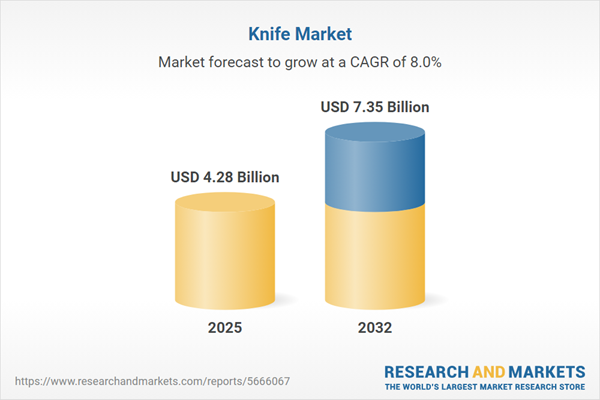Speak directly to the analyst to clarify any post sales queries you may have.
The global knife market is navigating an era of rapid evolution as product innovation, hybrid distribution models, and shifting procurement standards fundamentally reshape competitive dynamics. Decision-makers across manufacturing, distribution, and sourcing must align strategies to capitalize on emerging trends while mitigating operational risks.
Market Snapshot: Knife Market Growth and Strategic Outlook
The Knife Market expanded from USD 3.96 billion in 2024 to USD 4.28 billion in 2025, with strong momentum projected through a CAGR of 8.04%. The sector is forecast to reach USD 7.35 billion by 2032, underpinned by robust demand across both consumer and professional segments. Market expansion is fueled by advancements in materials, evolving consumer and professional requirements, and impactful shifts in supply chain management and distribution practices.
Scope & Segmentation
- Product Types: Hunting Knife, Kitchen Knife (Bread, Chef, Paring), Pocket Knife, Tactical Knife (Law Enforcement, Military), Utility Knife
- Distribution Channels: Direct Sales, Online Retail (Manufacturer Website, Third Party Marketplace), Specialty Stores, Supermarkets
- End Users: Home User, Professional (Butchers, Chefs)
- Blade Materials: Carbon Steel, Ceramic, Composite, Stainless Steel (Austenitic, Martensitic)
- Handle Materials: Composite, Metal, Plastic, Wood
- Applications: Cooking (Carving, Preparation), Outdoor (Camping, Fishing), Tactical Use (Law Enforcement, Military)
- Regions: Americas (United States, Canada, Mexico, Brazil, Argentina, Chile, Colombia, Peru), Europe, Middle East & Africa (United Kingdom, Germany, France, Russia, Italy, Spain, Netherlands, Sweden, Poland, Switzerland, United Arab Emirates, Saudi Arabia, Qatar, Turkey, Israel, South Africa, Nigeria, Egypt, Kenya), Asia-Pacific (China, India, Japan, Australia, South Korea, Indonesia, Thailand, Malaysia, Singapore, Taiwan)
- Leading Companies: Zwilling J.A. Henckels AG & Co. KGaA, Fiskars Corporation, Kai Corporation, Wüsthof Dreizackwerk GmbH & Co. KG, Victorinox AG, Tramontina S.A., Cangshan Cutlery Co., Ltd., Messermeister LLC, Buck Knives LLC, Chicago Cutlery LLC
Key Takeaways for Senior Decision-Makers
- Material innovation is intensifying, with advanced blade alloys and ceramics expanding product differentiation while enabling new ergonomic and functional features.
- Hybrid distribution models blend direct sales, specialty retail, and digital marketplaces to provide greater channel flexibility and margin optimization for manufacturers.
- Procurement complexity is rising, as professional buyers and regulatory agencies demand comprehensive traceability, compliance, and lifecycle documentation.
- Regional market strategies differ sharply, shaped by local procurement rules, consumer preferences, and the presence of manufacturing hubs, requiring localized go-to-market approaches.
- End-user priorities are increasingly segmented, with home users valuing aesthetics and ease of maintenance, while professionals demand certifications and enhanced serviceability.
- Supply resilience and adaptability are now strategic imperatives, as diversified sourcing and modular design become critical responses to evolving trade and tariff environments.
Tariff Impact and Supply Chain Adjustments
Recent tariff changes have prompted stakeholders to rethink sourcing, pricing, and supplier strategies. Companies are intensifying supplier qualification and developing dual-sourcing to balance cost and reduce single-origin risks. Procurement leaders are also prioritizing component modularity to allow flexible substitutions based on tariff implications. Retailers, meanwhile, have adjusted their product assortments to minimize exposure and ensure supply continuity, demonstrating how regulatory shifts directly influence channel and inventory strategies.
Methodology & Data Sources
Research findings are grounded in structured interviews with industry leaders, technical material evaluations, and analysis of regulatory developments. The study triangulates data from senior product, sourcing, and sales roles, supported by laboratory summaries, supplier documentation, and trade policy mapping to ensure high validity. This robust method provides actionable insights for strategic decisions in a rapidly changing knife market.
Why This Report Matters
- Offers actionable intelligence for aligning product development, supply chain resilience, and channel orchestration with evolving market demands.
- Equips executives with insights on material choices, certification standards, and compliance for both consumer and professional segments.
- Enables clear benchmarking of geographic markets and major suppliers to inform expansion and partnership strategies.
Conclusion
The knife industry is evolving through innovation, agile sourcing, and sophisticated distribution. Senior leaders who align technology, procurement, and channel tactics will secure growth and resilience in this dynamic global market.
Additional Product Information:
- Purchase of this report includes 1 year online access with quarterly updates.
- This report can be updated on request. Please contact our Customer Experience team using the Ask a Question widget on our website.
Table of Contents
3. Executive Summary
4. Market Overview
7. Cumulative Impact of Artificial Intelligence 2025
Companies Mentioned
The companies profiled in this Knife market report include:- Zwilling J.A. Henckels AG & Co. KGaA
- Fiskars Corporation
- Kai Corporation
- Wüsthof Dreizackwerk GmbH & Co. KG
- Victorinox AG
- Tramontina S.A.
- Cangshan Cutlery Co., Ltd.
- Messermeister, LLC
- Buck Knives, LLC
- Chicago Cutlery, LLC
Table Information
| Report Attribute | Details |
|---|---|
| No. of Pages | 186 |
| Published | October 2025 |
| Forecast Period | 2025 - 2032 |
| Estimated Market Value ( USD | $ 4.28 Billion |
| Forecasted Market Value ( USD | $ 7.35 Billion |
| Compound Annual Growth Rate | 8.0% |
| Regions Covered | Global |
| No. of Companies Mentioned | 11 |









